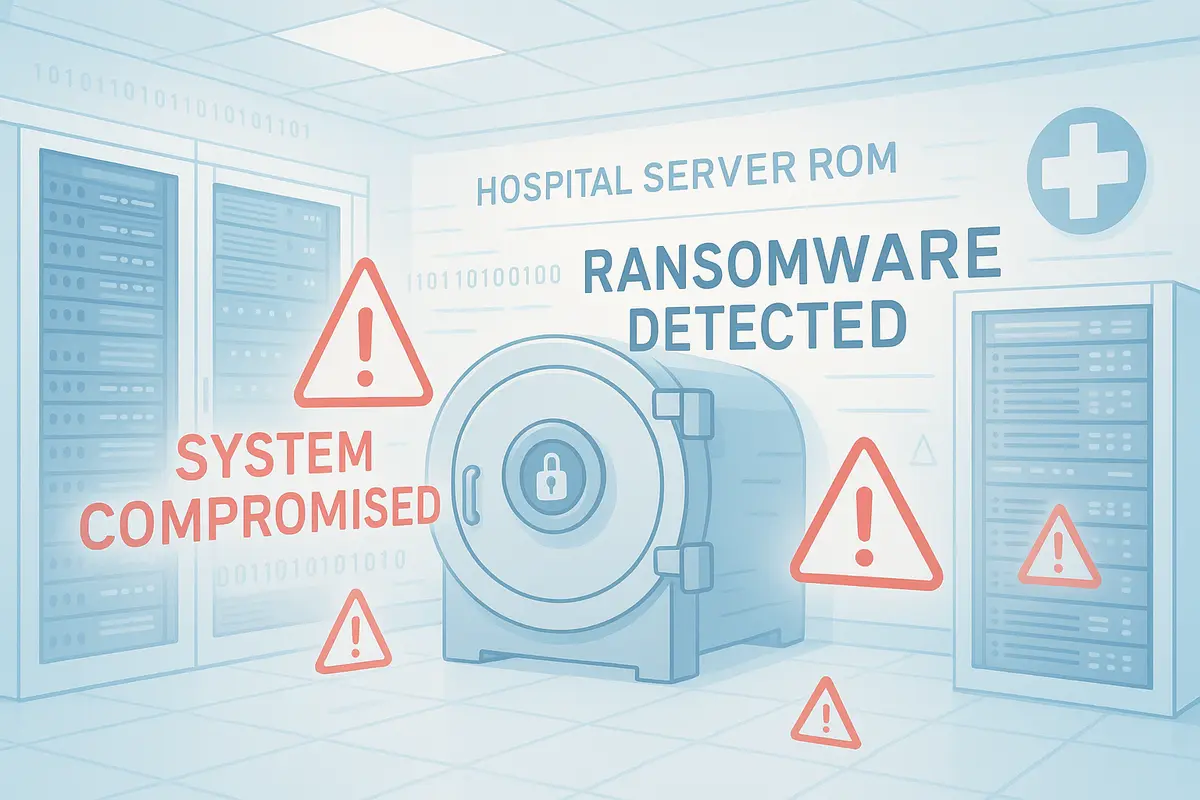True Horror: Real-Life Cyber Attack Cripples Hospital
Real-Life Cyber Attack: How a Hospital Was Taken Down in 2025
In early 2025, a real-life cyber attack shut down an American hospital’s entire network. This wasn’t a test, or a simulation—it was a full-blown ransomware disaster that risked patients’ lives, halted surgeries, and caused millions in damage.
This true story reveals just how vulnerable critical infrastructure has become. If a hospital can be taken down in minutes, no one is truly safe. Here’s exactly what happened—and what we can learn from it.
Table of Contents
Inside a Real-Life Cyber Attack: The Timeline of Chaos
On March 3, 2025, St. Vincent Medical Center in Toledo, Ohio experienced a sudden and severe ransomware attack. At 2:47 a.m., the hospital’s systems started failing:
- 📁 Medical records became inaccessible
- 🛑 Patient monitoring systems went offline
- 📞 Internal communications were disabled
Ambulances were redirected. Surgeries were cancelled. Staff reverted to paper charts and flashlights. This wasn’t just a cyber event—it was a physical emergency caused by digital negligence.
Who Was Behind This Real-Life Cyber Attack?
A cybercriminal group called BlackFog Syndicate, active on the dark web, claimed responsibility. They infiltrated the system through an unsecured remote access point and deployed their ransomware: DarkVault-X.
“We own your data. Pay $2M in Bitcoin, or lose it forever.”
– Message displayed on every hospital workstation
This real-life cyber attack was deliberate, targeted, and brutally efficient.
How the Hack Happened
Weak Entry Point
The attack started with a single compromised credential. An IT staff member logged in from home using a leaked password: Spring2023!.
Rapid Lateral Movement
Once inside, the attackers ran PowerShell scripts to spread ransomware across the network, encrypting over 4,000 endpoints.
Full Operational Shutdown
Everything—from lab results to imaging, pharmacy systems, and internal phones—was taken offline.
This real-life cyber attack paralyzed a hospital in minutes.
What Are the Real Consequences?
This real-life cyber attack had devastating consequences—financially, operationally, and even medically.
Here’s a breakdown of what happened after the hospital systems were compromised:
| Impact | Description |
|---|---|
| Operations Halted | 4,000+ systems encrypted; surgeries & admissions stopped |
| Financial Damage | Estimated cost over $7.3M in recovery and lost data |
| Patient Safety | 1 confirmed death linked to tech failure |
| Recovery Time | Over 60 days to fully restore systems |
| Public Trust | Confidence in hospital security drastically dropped |
This wasn’t just about stolen data. It was about lives being put at risk.
Lessons from a Real-Life Cyber Attack
Use Strong Passwords + 2FA Everywhere
This incident started with one reused password. Combine strong passwords with two-factor authentication (2FA).
Patch Outdated Systems
The hospital ran an unpatched Windows Server 2012. Critical vulnerabilities were known. Update or get exposed.
Train Staff to Spot Threats
Many cyber attacks succeed due to human error. Training staff in phishing prevention and security basics saves lives.
Run Attack Simulations
Simulated ransomware drills can test your systems under real pressure and reveal weak points before hackers do.
Why Real-Life Cyber Attacks Are on the Rise
- 60% of U.S. hospitals were hit by ransomware in the last 12 months
- Hackers now target data and operations, not just money
- Many organizations lack basic cybersecurity hygiene
In this case, all it took was one mistake.
FAQ: Real-Life Cyber Attacks
How common are ransomware attacks in 2025?
Very common. Over 60% of hospitals in the U.S. reported at least one attack in the past year. Healthcare is now a prime target for cybercriminals.
Can strong passwords alone stop an attack?
No. Strong passwords help, but without 2FA and layered defense, hackers can still get in through phishing, software flaws, or remote access.
Should small businesses be worried too?
Absolutely. 43% of cyber attacks in 2025 targeted businesses with fewer than 50 employees—often because they’re easier to breach.
Final Thoughts: A Real-Life Cyber Attack Could Happen to You
This real-life cyber attack wasn’t fiction. It wasn’t a drill. It was a devastating, preventable failure that affected lives.
If it can happen to a hospital, it can happen to your business, your school, your startup—even your home network.
Want to Stay Safe?
👉 Download our FREE cybersecurity guide for 2025
https://www.cybersecurityinsightx.com/free-cybersecurity-guide-2025/
Protect your systems, your data, and your peace of mind.


